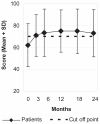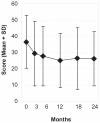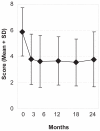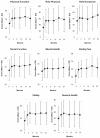Long-term outcomes of anthroposophic therapy for chronic low back pain: A two-year follow-up analysis
- PMID: 21197296
- PMCID: PMC3004618
- DOI: 10.2147/jpr.s5922
Long-term outcomes of anthroposophic therapy for chronic low back pain: A two-year follow-up analysis
Abstract
Background: Anthroposophic treatment for chronic low back pain (LBP) includes special artistic and physical therapies and special medications. In a previously published prospective cohort study, anthroposophic treatment for chronic LBP was associated with improvements of pain, back function, and quality of life at 12-month follow-up. These improvements were at least comparable to improvements in a control group receiving conventional care. We conducted a two-year follow-up analysis of the anthroposophic therapy group with a larger sample size.
Methods: Seventy-five consecutive adult outpatients in Germany, starting anthroposophic treatment for discogenic or non-specific LBP of ≥6 weeks' duration participated in a prospective cohort study. Main outcomes were Hanover Functional Ability Questionnaire (HFAQ; 0-100), LBP Rating Scale Pain Score (LBPRS; 0-100), Symptom Score (0-10), and SF-36 after 24 months.
Results: Eighty-five percent of patients were women. Mean age was 49.0 years. From baseline to 24-month follow-up all outcomes improved significantly; average improvements were: HFAQ 11.1 points (95% confidence interval [CI]: 5.5-16.6; p < 0.001), LBPRS 8.7 (95% CI: 4.4-13.0; p < 0.001), Symptom Score 2.0 (95% CI: 1.3-2.8; p < 0.001), SF-36 Physical Component Summary 6.0 (95% CI: 2.9-9.1; p < 0.001), and SF-36 Mental Component Summary 4.0 (95% CI: 1.1-6.8; p = 0.007).
Conclusion: Patients with chronic LBP receiving anthroposophic treatment had sustained improvements of symptoms, back function, and quality of life, suggesting that larger multicenter rigorous studies may be worthwhile.
Keywords: anthroposophy; drug therapy; eurythmy therapy; follow-up studies; low back pain.
Figures





Similar articles
-
Anthroposophic therapy for migraine: a two-year prospective cohort study in routine outpatient settings.Open Neurol J. 2010;4:100-10. doi: 10.2174/1874205X01004010100. Epub 2010 Sep 8. Open Neurol J. 2010. PMID: 21673981 Free PMC article.
-
Long-term outcomes of anthroposophic treatment for chronic disease: a four-year follow-up analysis of 1510 patients from a prospective observational study in routine outpatient settings.BMC Res Notes. 2013 Jul 13;6:269. doi: 10.1186/1756-0500-6-269. BMC Res Notes. 2013. PMID: 23849335 Free PMC article.
-
Overview of the Publications From the Anthroposophic Medicine Outcomes Study (AMOS): A Whole System Evaluation Study.Glob Adv Health Med. 2014 Jan;3(1):54-70. doi: 10.7453/gahmj.2013.010. Glob Adv Health Med. 2014. PMID: 24753995 Free PMC article. Review.
-
Anthroposophic vs. conventional therapy for chronic low back pain: a prospective comparative study.Eur J Med Res. 2007 Jul 26;12(7):302-10. Eur J Med Res. 2007. PMID: 17933703 Clinical Trial.
-
Assessing the order of magnitude of outcomes in single-arm cohorts through systematic comparison with corresponding cohorts: an example from the AMOS study.BMC Med Res Methodol. 2008 Mar 19;8:11. doi: 10.1186/1471-2288-8-11. BMC Med Res Methodol. 2008. PMID: 18366683 Free PMC article. Review.
Cited by
-
Anthroposophic therapy for migraine: a two-year prospective cohort study in routine outpatient settings.Open Neurol J. 2010;4:100-10. doi: 10.2174/1874205X01004010100. Epub 2010 Sep 8. Open Neurol J. 2010. PMID: 21673981 Free PMC article.
-
Long-term outcomes of anthroposophic treatment for chronic disease: a four-year follow-up analysis of 1510 patients from a prospective observational study in routine outpatient settings.BMC Res Notes. 2013 Jul 13;6:269. doi: 10.1186/1756-0500-6-269. BMC Res Notes. 2013. PMID: 23849335 Free PMC article.
-
The Effects of Anthroposophic Medicine in Chronic Pain Conditions: A Systematic Review.J Integr Complement Med. 2023 Nov;29(11):705-717. doi: 10.1089/jicm.2022.0723. Epub 2023 Jun 26. J Integr Complement Med. 2023. PMID: 37358805 Free PMC article.
-
Anthroposophic medicine: an integrative medical system originating in europe.Glob Adv Health Med. 2013 Nov;2(6):20-31. doi: 10.7453/gahmj.2012.087. Glob Adv Health Med. 2013. PMID: 24416705 Free PMC article.
-
Overview of the Publications From the Anthroposophic Medicine Outcomes Study (AMOS): A Whole System Evaluation Study.Glob Adv Health Med. 2014 Jan;3(1):54-70. doi: 10.7453/gahmj.2013.010. Glob Adv Health Med. 2014. PMID: 24753995 Free PMC article. Review.
References
-
- Rubin DI. Epidemiology and risk factors for spine pain. Neurol Clin. 2007;25(2):353–371. - PubMed
-
- Mounce K. Back pain. Rheumatology (Oxford) 2002;41(1):1–5. - PubMed
-
- Ritchie J, Wilkinson J, Gantley M, Feder G, Carter Y, Formby J. A model of integrated primary care: anthroposophic medicine. London: Department of General Practice and Primary Care, St Bartholomew’s and the Royal London School of Medicine, Queen Mary, University of London; 2001.
-
- Kienle GS, Kiene H, Albonico HU. Anthroposophic medicine: effectiveness, utility, costs, safety. Stuttgart, New York: Schattauer Verlag; 2006.
LinkOut - more resources
Full Text Sources
Miscellaneous

